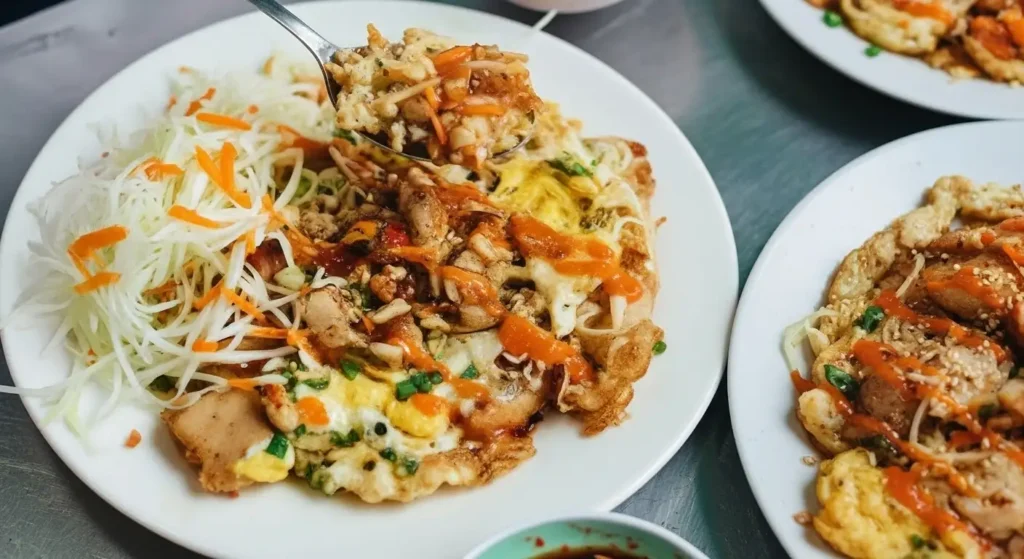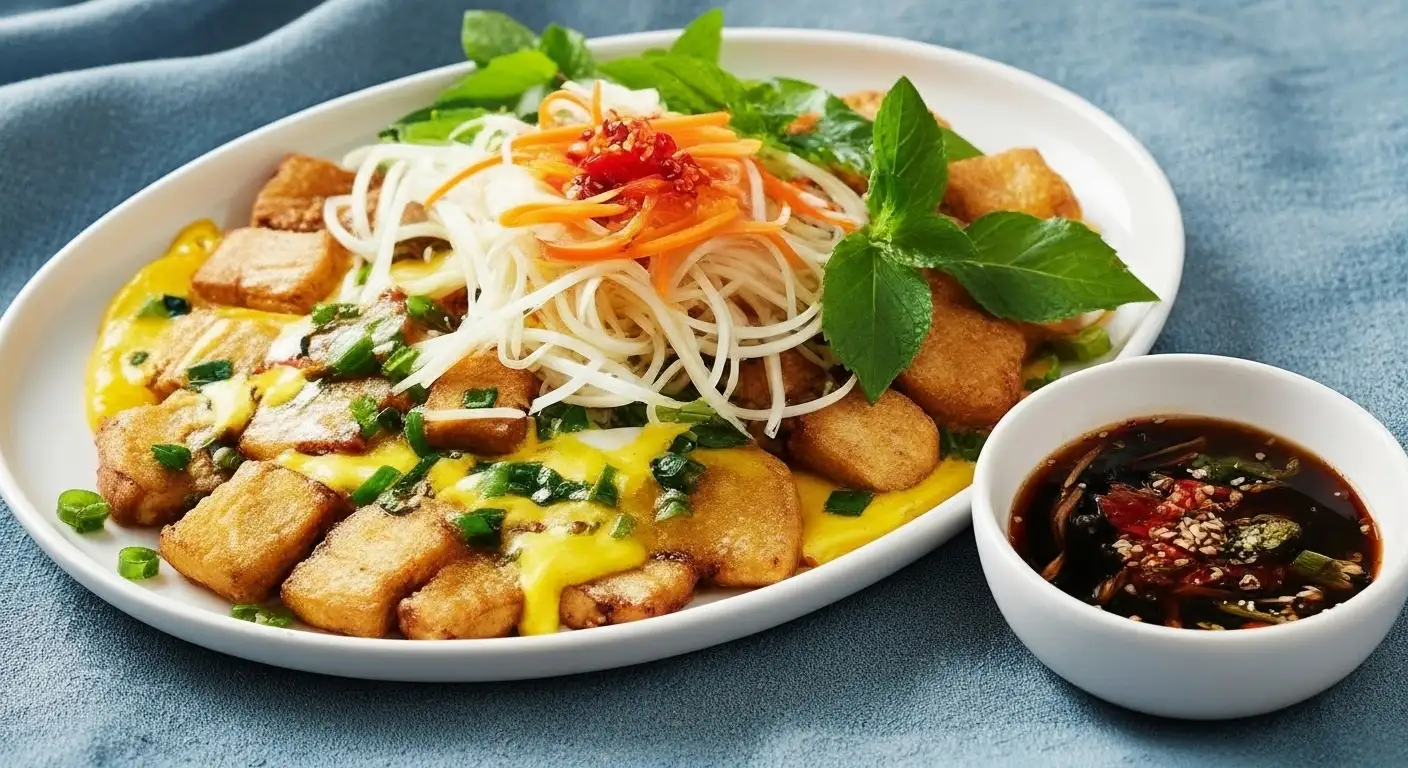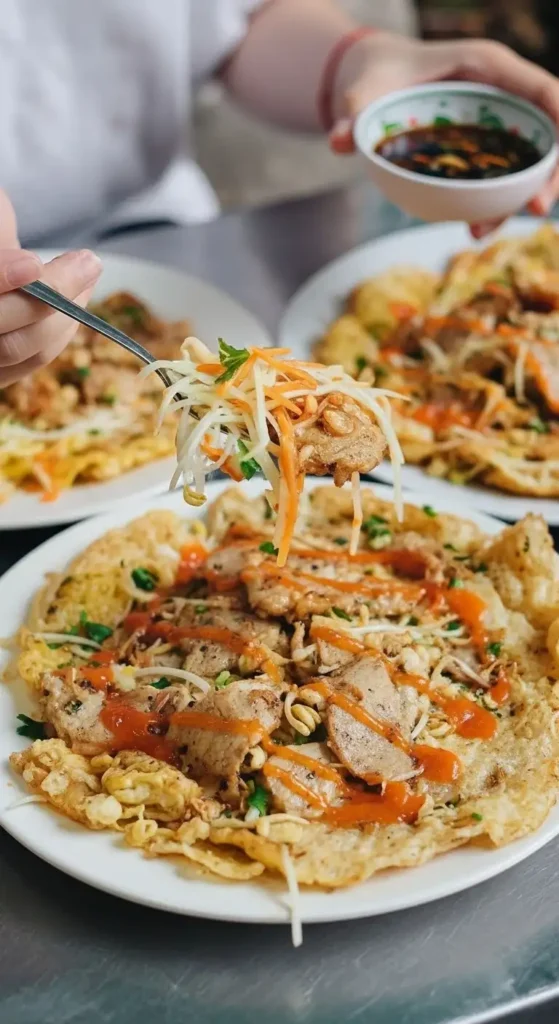Bột Chiên (pronounced roughly Boht Chee-en) is one of Southern Vietnam’s most beloved and iconic street foods, particularly prominent in Ho Chi Minh City (Saigon). Translating simply to “fried flour (or batter),” this dish is a delicious fusion of textures and flavors, combining crispy rice flour cakes with savory egg and a tangy dipping sauce.
Originating from a dish with Chinese (specifically Teochew) influences, Bột Chiên has been perfectly adapted to the Vietnamese palate, transforming a simple ingredient—rice—into a comforting, savory, and satisfying snack, often enjoyed by students and office workers in the afternoon or evening.

Bột Chiên: The Basics
The Cake (Bột): The foundation is a firm, gelatinous cake made primarily from rice flour and a little tapioca starch for chewiness. This batter is mixed, cooked until thick, and then steamed in a pan to set. Once cooled, the block is cut into small, bite-sized cubes or rectangles.
The Frying (Chiên): The cubes are pan-fried in a generous amount of oil until the edges are golden brown and wonderfully crispy, while the inside remains soft and chewy.
The Egg & Topping: The cubes are then pushed to one side of the pan, and a beaten egg (often duck or chicken) is poured over them, binding the cakes together like a savory omelet. It is topped with chopped green onions (hành lá) right before serving.
The Dipping Sauce: The soul of the Vietnamese version is a special, sweet, tangy, and slightly spicy soy-based sauce. It is usually a blend of soy sauce, sugar, vinegar, and fresh chili, balancing the richness of the fried cake and egg.
The Garnish: A serving is typically topped with crunchy pickled vegetables (Đồ Chua—shredded carrots and daikon) or fresh, shredded green papaya, providing a refreshing counterpoint to the oiliness of the fried elements.
Varieties of Bột Chiên
While the classic version is most common, vendors in Vietnam (and abroad) have developed a few key variations on the basic formula:
| Variety/Type | Key Feature | Description |
|---|---|---|
| Bột Chiên Trứng | Classic Egg Only | The standard, most popular version: fried rice cakes scrambled with egg and green onions. |
| Bột Chiên Củ Cải | Radish Cake | The rice cake mixture incorporates radish (củ cải) or sometimes taro, giving the cubes a slightly more complex, earthy flavor, similar to the Chinese origins of the dish. |
| Bột Chiên Tôm | Shrimp Added | Some vendors will add small, cooked shrimp to the mixture before frying, giving the dish a seafood twist and extra savory depth. |
| Bột Chiên Không Trứng | Egg-less | For customers who prefer a simpler snack, the cakes can be fried and served with just the dipping sauce and green onions, omitting the egg. |

How to Eat Bột Chiên
Bột Chiên is always eaten fresh and hot, directly from the sizzling pan, usually with minimal ceremony.
Drizzle the Sauce: The most common way to eat it is to liberally drizzle the entire plate of Bột Chiên with the tangy, sweet, and spicy dipping sauce.
Combine All Elements: Use a fork or chopsticks to break off a bite that includes the crispy rice cake, the tender egg, a piece of the fresh green onion, and some of the crunchy pickled vegetable garnish.
Eat Immediately: As a street food, it’s meant to be enjoyed right off the skillet. The contrast between the hot, crispy exterior of the cakes and the cool, crunchy pickles is essential to the experience.
Regional Differences
Bột Chiên is overwhelmingly a Southern Vietnamese specialty, and its prevalence significantly diminishes outside of the Southern provinces.
| Region | Popularity & Flavor Profile | Key Distinctions in Serving |
|---|---|---|
| South (Ho Chi Minh City / Saigon) | Extremely popular. Defined by the rich, greasy frying technique and the generous use of egg. The dipping sauce is distinctly sweet and sour with strong chili. | Always served with pickled vegetables (papaya/daikon) for crunch and acidity. Often served as a late-afternoon or evening snack. |
| Central (Miền Trung) | Rarely found. Not a traditional Central dish. | Central cuisine has its own distinct rice-based street foods, like Bánh Bèo or Bánh Nậm. Bột Chiên is generally absent from traditional Central menus. |
| North (Miền Bắc - Hanoi) | Non-existent/Unknown. Not part of the traditional Northern street food repertoire. | Northern cuisine prioritizes subtle, light flavors and techniques like steaming and stewing. Fried, heavy-oil dishes like Bột Chiên do not fit the traditional Northern culinary style. |




